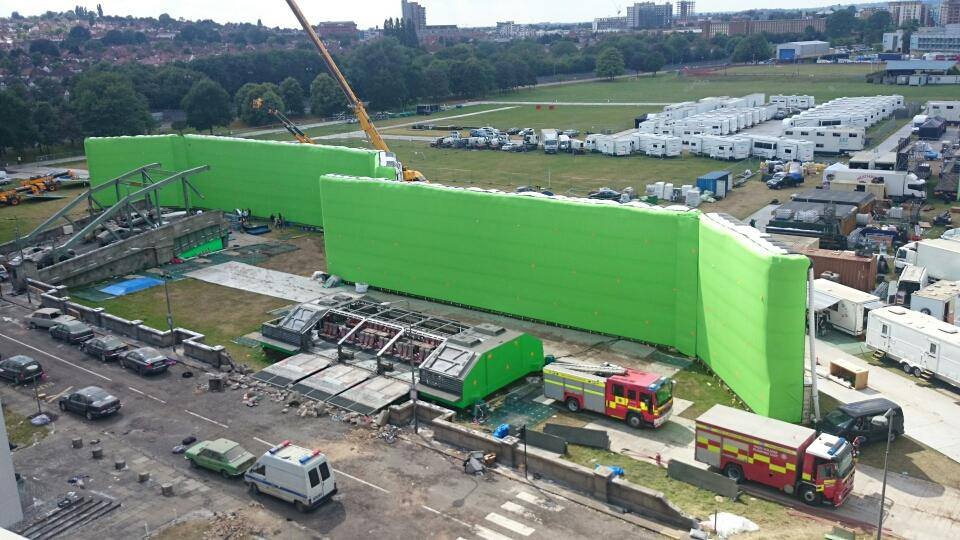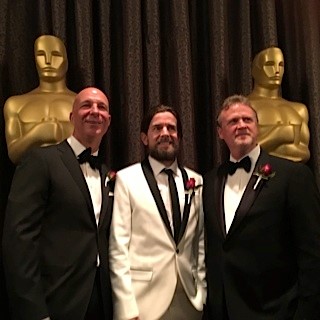Let’s meet the one guy on our NOTscars special who actually has been honored this week by the Academy of Motion Pictures Arts and Sciences: Steve Smith, a Canadian who co-created the “Airwall.”
The invention is like a giant air mattress standing on one edge, which can be inflated easily on a movie set and used as a green screen. Actors act in front of it, and later, special effects can be superimposed onto the screen. Watch it in action below.
For the Airwall, Steve and his co-conspirators nabbed one of the Academy’s Scientific And Technical Achievement awards, which are given out before the main Oscar ceremony and barely mentioned on the telecast.
So on this NOTscar show, we thought we’d give Steve his due. Rico first asked what Steve does in the film biz.

Steve Smith: I’ve been in the film industry now for about 40 years, working as a Key Grip.
Rico Gagliano: Which is what, for those who don’t know.
Steve Smith: A Key Grip is a film technician. We work with the lighting and the movement of the camera.
Rico Gagliano: They’re considered kind of the unsung heroes of a set — they’re like the tough guys that are moving heavy things around.
Steve Smith: Yeah.
Rico Gagliano: Did you expect ever to win an Oscar?
Steve Smith: No. [laughs] Never!
Rico Gagliano: What was the path that led you to create something that now is, you know, Oscar-worthy?
Steve Smith: Well, to diffuse the light over the actors, one of the things that Key Grips do is we put up large overhead frames. They’re like sails in the wind. Four thousand square feet of sail, basically. And they’re quite dangerous.
They can stand up to a certain amount of wind, but, if it’s a big storm they can blow over. So we were trying to figure out a way to make it easier on set, and not be worried all day long about “Is something bad going to happen if the wind comes up?”
So we came up with this inflatable overhead. Which then led us to say, “Hey, maybe we could make this as a wall as well!” Because another thing that we do is we put up large outdoor green screens.

Rico Gagliano: Right — and I understand that before you invented this inflatable wall, outdoor green screens had to be these giant wooden walls that you would erect on the set, basically.
Steve Smith: Well, yeah. For a movie I worked on called “42” we had a 1,400-foot green screen, forty feet tall. We did that with telephone poles. Stuck 187 telephone polls in the ground.
Rico Gagliano: Whereas now, you can just blow up, basically, a giant balloon.
Steve Smith: That’s right.
Rico Gagliano: I imagine there might be an example of a shot that you did that maybe would have been either very difficult or impossible without this thing — can you give an example?
Steve Smith: Well our very first experience on “Godzilla,” there was a shot where we needed a helicopter to come in at a low angle over the top of the Airwall. And the director was saying “It’s not low enough, I need it lower and lower.” And so we were able to just deflate our wall, and he was able to get his shot. And with a permanent wall he couldn’t have done that.
Rico Gagliano: That’s right. You can’t just, like, shave fifty feet off the top of a gigantic wooden structure!
Steve Smith: That’s right.
Rico Gagliano: To what extent has that revolutionized shooting? I mean, it’s obvious how much time it saves. How much money do you think something like that saves?
Steve Smith: Well, we say it’s about of a third of the cost. So, quite a bit.
Rico Gagliano: What movies has it been deployed on, the Airwall?
Steve Smith: Well, we started on “Godzilla,” “Tomorrowland.” From there we went to “Avengers” in London, “Pirates of the Caribbean” in Australia, “X-Men: Apocalypse.” Most of these are not out yet but…
Rico Gagliano: Can you tell me what the ending of that movie is?
Steve Smith: Which one?
Rico Gagliano: “X-Men: Apocalypse.”
Steve Smith: I cannot [laughs].
Rico Gagliano: I feel like winning an Oscar has changed you, man.
Steve Smith: Yeah, I know.
Rico Gagliano: Speaking of which, how did the Science and Technical Oscars work? Do you apply for the award? Is that how it goes?
Steve Smith: Yes. You do. I had applied when we did our first show, “Godzilla”… and it was instantly rejected [laughs].
Rico Gagliano: Why?
Steve Smith: Well, because, we had done one show. So, it wasn’tt really out there that people knew about.
Rico Gagliano: Yeah — you hadn’t saved enough people enough money, I think is how Hollywood works.
Steve Smith: I think you’re right! So, later we saved people a lot of money, and the Academy came and said “Why don’t you re-apply?”
And then I was sitting at my desk, and got an email from our partner here in the U.S., Evan Green, and he said, “Congrats on the award!” I had no idea. He had already seen it in “Variety.” Which in Vancouver we don’t really get “Variety.” So, that’s how I found out.
Rico Gagliano: So the Science And Technical awards, let’s be honest… they don’t get much air time on the actual Oscar telecast. They’ll show maybe three seconds of an award-winner’s speech. So, are you maybe designing your speech such that there’s a perfect soundbite?
Steve Smith: So they have to show it?
Rico Gagliano: Yeah.
Steve Smith: You know, that’s a good idea. I just don’t know what I would say.
Rico Gagliano: I don’t know either, but it should be short. If you were going to describe this invention in three words, what would you use?
Steve Smith: Giant, bouncy, castle. [Laughs.]


